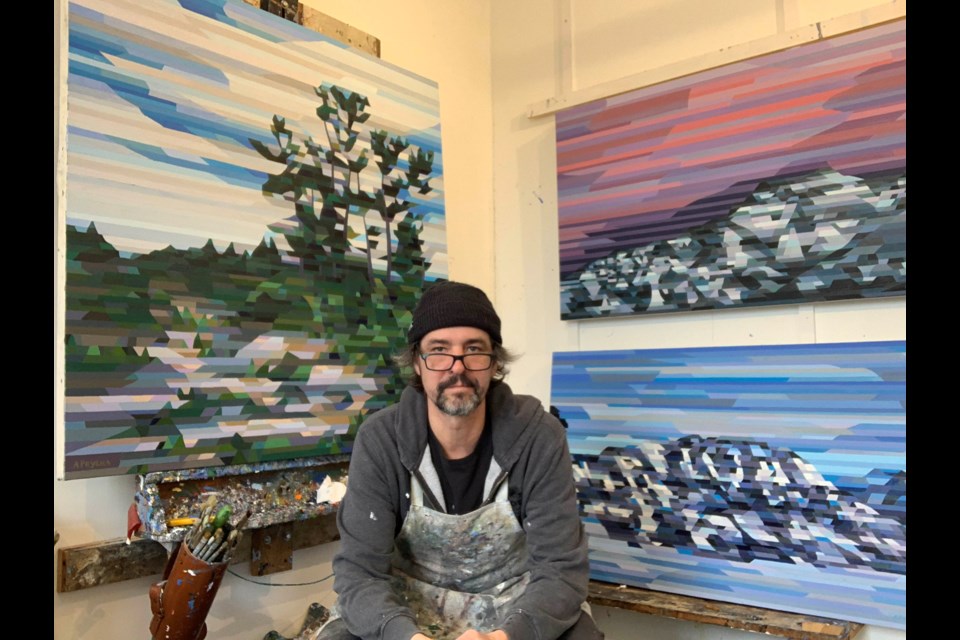Although he spent eight years in the Toronto area, the call of his hometown of Collingwood brought Andrew Peycha back years ago to live out his dream of being a painter.
For this week’s edition of People of Collingwood we spoke with Peycha, 48, a local artist.
Q: Where did you grow up?
A: I grew up in Collingwood.
I went to St. Mary’s Catholic School and Collingwood Collegiate Institute, occasionally. (laughs)
I moved away for about eight years.
I moved back after that and never left.
Q: Did you always know you wanted to be an artist?
A: I dabbled with the idea of being a pilot. In the end, I realized I wasn’t very good with physics.
I decided art was a better forum for me.
Q: When you went away for eight years, did you go to school for art, or something else?
A: I went away to school for illustration at Sheridan College.
I was trained in fine art and technical drawing. It was really meant to get you out in the field of illustrations for newspapers or magazines. I was out of school in three years.
They put you in a job placement, and I got one at Reactor Art & Design. They represented illustrators across North America and Europe and they had contracts with The Bay and I believe Eaton’s at one point in time.
Before I was done school I was also getting jobs with the Globe & Mail and the Toronto Star. I would read stories or columns and come up with a drawing that represented that story. It was great.
At the time, I would have four days a week doing illustrations for the Star, and then I’d get the odd one (for a magazine).
Q: At what point did you decide to come back to Collingwood?
A: Well, I also kept a part-time job. I was a car jockey for a rental car agency, and I was driving past galleries all the time.
My end-game plan, so to speak, was to paint.
I joke now that I retired early.
It was an interesting time too because now, you can buy stock art. This was just starting at that time. The newspaper and magazine industry was changing because then, people were starting to (move to virtual), and see their news on Twitter.
It was evolving quite rapidly and the budgets for editorial in magazines and newspapers were dying. They wouldn’t want to pay $150 (for an illustration). They’d rather pay $20 (for a stock illustration).
I moved back home, which thrilled my parents, obviously.
I started pursuing the gallery aspect of painting. I had part-time jobs too.
I built clients up. I knew it was important to be online with your craft and have a presence. I still believe that.
Q: Can you describe your current art style?
A: I call it linear paintings. Basically, what I did is I took impressionism and cubism and modern art and smashed it all into one. It took a couple of years to get it refined.
It’s almost like Lego. I’ve had a fascination with Lego all my life.
It’s generalizing shapes and forms so you have lights light, darks dark and middle tones and I put it into a restricted pattern to create motion.
Believe it or not, I almost failed colour theory. (laughs)
Q: You were the artist chosen to create art on Collingwood utility boxes. Can you tell me how that came about?
A: I was asked to provide an image by the Collingwood BIA. They wanted to see how the image would look as a wrap. I said sure.
I think it’s great to make things a little more interesting. It’s a previous painting I had done made into a wrap.
I hadn’t really done anything of that nature before. I do commissions all the time, but never in public.
For me, it was interesting because they want to decorate these boxes, which are hideous. There’s lot of art out there that could be made into wraps, and it makes it look really cool.
I’m hoping they’ll move forward with (more).
Q: In your opinion, why is public art so important?
A: I think public art is important because it gives something different to look at. We have architectural design all around us. I find it nice to have something to break that up a little bit.
I love going places and seeing murals they have around their towns.
It would be nice to see more sculptures around here.
It adds a conversation piece. There are people who go around from town to town looking for murals.
Supporting arts in a community is great because then people don’t have to have part-time jobs. (laughs)
Q: What does the future hold for you? Do you have any dream pieces you’d like to create?
A: I’m happy being able to create on a daily basis. It’s a wonderful privilege to be able to do that.
To make a living out of what I do has taken a long time.
I’d love to be in a big gallery or museum one day, but I’m not going to necessarily go out and knock on doors to pursue that. A lot of times with this, things just happen when they happen.
I’m just happy to be able to work and create images for people who really enjoy them.
For our feature People of Collingwood, we’ll be speaking with interesting people who are either from or are contributing to the Collingwood community in some way, letting them tell their own stories in their own words. This feature will run on CollingwoodToday every weekend. If you’d like to nominate or suggest someone to be featured in People of Collingwood, email [email protected].



